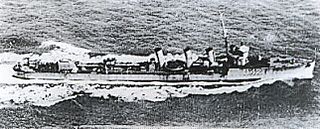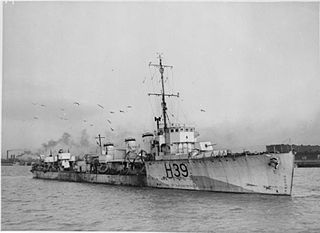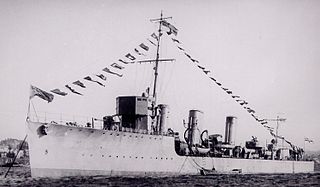This is a list of destroyer classes of the Royal Navy of the United Kingdom, organised chronologically by entry into service.
This is a list of destroyer classes of the Royal Navy of the United Kingdom, organised chronologically by entry into service.
In 1913, the surviving members of the large heterogeneous array of older 27-knot and 30-knot torpedo boat destroyer types (all six of the original 26-knot ships had been disposed of by the end of 1912) were organised into the A, B, C and D classes according to their design speed and the number of funnels they possessed. All were of a "turtle-back" design and, excepting a few "builder's specials", powered by reciprocating engines. It should be stressed that these A to D class designations did not exist before 1913, and only applied to those "turtle-backed" destroyers surviving to that time.
In 1913, lettered names were given to all Royal Navy destroyers, previously known after the first ship of that class. The River or E class of 1913 were the first destroyers of the Royal Navy with a high forecastles instead of "turtleback" bow making this the first class with a more recognizable modern configuration.
The following were ordered as part of the War Emergency Programme classes:
Source: [1]

HMS Arab was a B-class torpedo boat destroyer of the British Royal Navy. She was laid down by J & G Thomson at Clydebank and completed by John Brown & Company who took over the yard.

The V and W class was an amalgam of six similar classes of destroyer built for the Royal Navy under the 9th, 10th, 13th and 14th of fourteen War Emergency Programmes during the First World War and generally treated as one class. For their time they were among the most powerful and advanced ships of their type in the world, and set the trend for future British designs.

HMS Bat was a Palmer-built three funnel, 30 knot torpedo boat destroyer ordered by the Royal Navy under the 1895 – 1896 Naval Estimates. She was the third ship to carry this name since it was introduced in 1815 for a revenue cutter in service until 1848. Bat was classified along with similar vessels as a C-class destroyer in 1913.

The River-class destroyer was a class of torpedo boat destroyer built for the Royal Navy in the first few years of the 20th century, and which saw extensive service in World War I. These 37 vessels were all constructed to disparate builders' designs, just like the preceding classes.

The C class as designated in 1913 was a heterogeneous group of torpedo boat destroyers (TBDs) built for the Royal Navy in the late-1890s. They were constructed to the individual designs of their builders to meet Admiralty specifications. The uniting feature of the class was a top speed of 30 knots, a "turtleback" forecastle and that they all had three funnels. The funnels were spaced equidistantly and were of equal height, but the central one was thicker.

The Yarrow M class was a class of ten destroyers built for the Royal Navy that saw service during World War I. They were generally similar to the standard Admiralty M-class destroyer, but were instead designed by the builder, Yarrow & Company. Generally, they had two instead of three shafts, as well as two funnels and a straight stern, with the bridge set well back from the forecastle. The first trio were two knots faster than the Admiralty M type, despite less installed power and one less shaft; the installed power was increased for the later vessels. Jane's Fighting Ships describes the class as "very successful boats", and all ten vessels survived throughout the war to be broken up during the 1920s. Moon, Mounsey and Musketeer were each fitted to carry a kite balloon.

The M class, more properly known as the Admiralty M class, were a class of 85 destroyers built for the Royal Navy of United Kingdom that saw service during World War I. All ships were built to an identical – Admiralty – design, hence the class name. Eighteen other vessels which were officially included within the 'M' class were built to variant designs by three specialist builders – 10 by Yarrow, 6 by Thornycroft, and 2 by Hawthorn Leslie; these are covered in other articles.

The Thornycroft M or Mastiff class were a class of six British destroyers completed for the Royal Navy during 1914–16 for World War I service. They were quite different from the Admiralty-designed ships of the Admiralty M class, although based on a basic sketch layout provided by the British Admiralty from which J I Thornycroft developed their own design. Like the 'standard' Admiralty M class they had three funnels, but the centre funnel was thicker in the Thornycroft ships. The midships 4-inch (100 mm) gun was shipped between the second and third funnels. Patriot was fitted to carry a kite balloon.

The A class as designated in 1913 was a heterogeneous group of torpedo boat destroyers (TBDs) built for the Royal Navy in the mid-1890s. Some 42 vessels were constructed to the individual designs of their builders to meet Admiralty specifications, the only uniting feature being a specified top speed of 27 knots (50 km/h). In fact the initial six vessels were generally differentiated by a slightly lower speed and were often referred to as "26-knotters" to distinguish them from the following batch of thirty-six vessels; all fifteen surviving "27-knotter" vessels were classified by the Admiralty as the A class in 1913 to provide some system to the naming of HM destroyers. All of the "26-knotters" and most of the "27-knotters" had been lost or scrapped before the 1913 classification, but for convenience all 42 ships are listed below. The number of funnels varied from one to four. All vessels had a distinctive "turtleback" forecastle that was intended to clear water from the bow, but actually tended to dig the bow in to anything of a sea, resulting in a very wet conning position.

The D class as they were known from 1913 was a fairly homogeneous group of torpedo boat destroyers (TBDs) built for the Royal Navy in the mid-1890s. They were all constructed to the individual designs of their builder, John I. Thornycroft & Company of Chiswick, to meet Admiralty specifications. The uniting feature of the class was a top speed of 30 knots and they all had two funnels.

The B class as designated in 1913 was a heterogeneous group of torpedo boat destroyers (TBDs) built for the Royal Navy in the late 1890s. They were constructed to the individual designs of their builders to meet Admiralty specifications, the uniting feature being a specified top speed of 30 knots (56 km/h) and four funnels, although the funnel spacings differed between ships. All "30 knotter" vessels with four funnels were classified by the Admiralty as the B class in 1913 to provide some system to the naming of HM destroyers. At the same time all "30 knotter" vessels with three funnels were classified by the Admiralty as the C class and those with two funnels became the D class.

The first R class were a class of 62 destroyers built between 1916 and 1917 for the Royal Navy. They were an improvement, specifically in the area of fuel economy, of the earlier Admiralty M-class destroyers. The most important difference was that the Admiralty R class had two shafts and geared turbines, compared with the three shafts and direct turbines of the Admiralty M class, but in appearance the R class could be distinguished from its predecessors by having the after 4-inch gun mounted in a bandstand. The Admiralty ordered the first two of this class of ships in May 1915. Another seventeen were ordered in July 1915, a further eight in December 1915, and a final twenty-three in March 1916.
HMS Thrasher was a "thirty-knotter" torpedo boat destroyer of the British Royal Navy. She was completed by Laird, Son & Company, Birkenhead, in 1897. One of four Quail-class destroyers, she served in the First World War, sinking the German submarine UC-39 in 1917, and was sold off after hostilities ended.

HMS Express was a B-class torpedo boat destroyer of the British Royal Navy. She was completed by Laird, Son & Company, Birkenhead, in 1896. Like many contemporary British destroyers, she was a "builder's special", designed to Admiralty specifications but built to the builder's own design.
HMS Boxer was an Ardent-class destroyer which served with the Royal Navy, launched on 28 November 1894. She spent several years operating with the Mediterranean Fleet and remained active during the First World War. She was sunk in a collision on 8 February 1918.

HMS Bruizer was an Ardent-class destroyer which served with the Royal Navy. She was launched on 27 February 1895 by John Thornycroft at Chiswick, and was sold on 26 May 1914.
Two Swordfish-class destroyers served with the Royal Navy. Swordfish and Spitfire were both built by Armstrong Whitworth at Elswick, Tyne and Wear launching in 1895. Fitted with Yarrow boilers, they could make 27 knots and were armed with one twelve pounder and two torpedo tubes.

HMS Fame was a two funnel, 30 knot destroyer of the Royal Navy, ordered under the 1894–1895 Naval Estimates. She was launched in 1896, served exclusively in Chinese waters and was sold at Hong Kong in 1921.

HMS Rapid was a destroyer of the M class that served with the Royal Navy during First World War. Launched by Thornycroft in 1916, the vessel was the one of two similar ships ordered as part of the Fifth War Construction Programme. They differed from the remainder of the M class in having more powerful engines. The design was used as the basis for the subsequent five ships of the R-class also built by the yard. Rapid served in escort and patrol roles, principally providing defence from submarines as part of the Grand Fleet until it was disbanded at the end of the War. After the end of hostilities, the vessel served in minor roles, including briefly as part of the Admiralty Compass Department in 1921 and 1924, but was sold to be scrapped in 1927.

HMS Ready was a destroyer of the M class that served with the Royal Navy during First World War. Launched by Thornycroft in 1916, the vessel was the one of two similar ships ordered as part of the Fifth War Construction Programme. They differed from the remainder of the M class in having more powerful engines. The design was used as the basis for the subsequent five ships of the R-class also built by the yard. Ready operated within the Grand Fleet until it was disbanded at the end of the war. The vessel was credited with helping to sink a German Q-ship in 1917. After the war, the destroyer was initially transferred to HMNB Portsmouth, but was retired and sold to be broken up in 1926 after almost a decade of service as part of a preparation for a fleet of new destroyers.